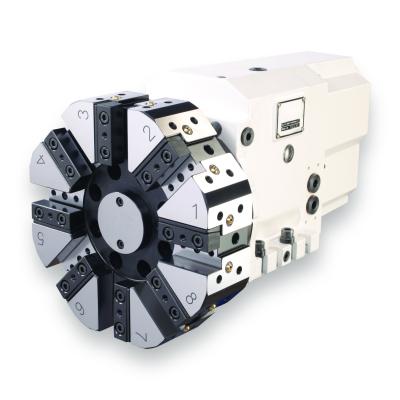
Automatic Tool Changers Inc. introduces a complete range of economical tool turrets for CNC lathes and turning centers, including replacements for the discontinued Dorian turrets as used on many HAAS TL series lathes. All turrets use a three-piece Hirth tooth coupling for high accuracy and maximum rigidity, plus allowing turrets to index without the tool carrier lifting.
The turrets can be used in any attitude and are totally sealed for use in the most demanding environments.
Disc-type turrets with “static” tooling are offered in six frame sizes fitted with an electro-mechanical, hydraulic or servomotor drive train.
Turrets with axial or radial oriented “live” tooling are also available in the most popular sizes prepared for either BMT or VDI tooling, standard spindles and toolholders.
Square tool post-type turrets with an electro-mechanical drive are offered in four basic frame sizes designed for use on flat bed lathes and VTLs.
To simplify the installation, ATC also offers an optional self-contained controller that allows automatic, semiautomatic and manual operation.
Contact Details
Related Glossary Terms
- centers
centers
Cone-shaped pins that support a workpiece by one or two ends during machining. The centers fit into holes drilled in the workpiece ends. Centers that turn with the workpiece are called “live” centers; those that do not are called “dead” centers.
- computer numerical control ( CNC)
computer numerical control ( CNC)
Microprocessor-based controller dedicated to a machine tool that permits the creation or modification of parts. Programmed numerical control activates the machine’s servos and spindle drives and controls the various machining operations. See DNC, direct numerical control; NC, numerical control.
- flat ( screw flat)
flat ( screw flat)
Flat surface machined into the shank of a cutting tool for enhanced holding of the tool.
- turning
turning
Workpiece is held in a chuck, mounted on a face plate or secured between centers and rotated while a cutting tool, normally a single-point tool, is fed into it along its periphery or across its end or face. Takes the form of straight turning (cutting along the periphery of the workpiece); taper turning (creating a taper); step turning (turning different-size diameters on the same work); chamfering (beveling an edge or shoulder); facing (cutting on an end); turning threads (usually external but can be internal); roughing (high-volume metal removal); and finishing (final light cuts). Performed on lathes, turning centers, chucking machines, automatic screw machines and similar machines.






